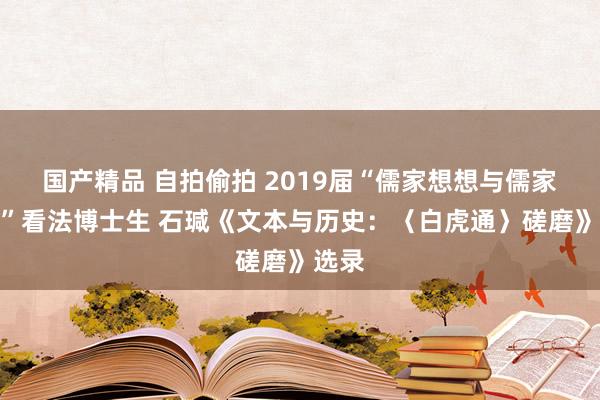
选录:东汉章帝建初四年(79)所举行的白虎不雅集议是东汉政事与经学的迫切事件。会后国产精品 自拍偷拍,章帝命史臣将会议计划所得,著成《白虎通》。此论文主要弃取文本与历史干系照的视角,以《白虎通》为中心,具体磋磨白虎不雅集议的配景,《白虎通》的生成过程、体例特征、真义抒发,以及《白虎通·爵》的想想内容与汉代轨制的关系问题,并最终尝试揭示白虎不雅集议的执行结局过甚在汉代政事、经学史上的真义。
论文第一章通过记忆西汉甚而东汉初年的历史,呈报白虎不雅集议的配景。论文以为儒学与汉代政事深度聚首而产生了“制礼”瞎想。东汉初年的“制礼”尝试被赋予了连接和发展“中兴”伟业的真义。与西汉追求收复经典中的“古制”不同,东汉“制礼”追究在参考经典的基础上,因革以损益。但这时经学发展博士滋繁而导致的众说不一的情况,成为了“制礼”的最大遏抑。为整合经学资源,以期到手的完毕礼法筹谋,章帝召开了白虎不雅集议。
论文第二章通过对汉代会议轨制汉文本的生成与流周折制的分析,计划《白虎通》文本的生成过程,指出《白虎议奏》是那些由淳于恭彙集奏上,恭候皇帝批答的文本的总采集。进而参考同期代的同样文本,预计《白虎通德论》是议奏经皇帝批答转成诏书而最终为班固所撰集者。而《白虎通》则是章帝会后命史官据会议档案《白虎通德论》改著而成的想想著述。明了这一过程,意味著解读《白虎通》文本与历史的关系需要与之反向而行。
论文第三章分析《白虎通》的文本步地与表意特征。问答末节是《白虎通》文本的基本表意单位。这种文本单位行为义与事的聚首体,重在探寻事物背后确固然之义。从义事聚首上说,《白虎通》的表意机制是由义以择事,想想建构性强。而“一说”与“或曰”行为文本的非常结构,其作用是在使文本容纳住对义事聚首酿成挑战内容的同期,又维系住这种表意机制。因为“通义”这种非常的体例,章帝君臣得以尝试建构东汉制礼的经学基础。
论文第四章通过对《白虎通·爵》的分析,磋磨其想想内容与汉代轨制的关系。礼法的骨子是基于执行权益而对社会次第的轨则。而在社会中,爵位是个东谈主身份特权最径直的标定与呈现。故《白虎通》以《爵》行为全书的开篇,也即想想建构的起原。《白虎通》诈骗经学资源建构起表里爵的等第序列,使之成为了汉代执行轨制的镜像。同期,该书借助《孝经》纬的资源,完成了“皇帝”爵性质的论证,奠定了爵制形而上的正当性基础。临了,《爵》所筹谋的即皇帝位的过程,与汉代轨制既有适宜又有各异。这线路了会议之中君臣的不对。
白虎不雅集议君臣之间的不对使得章帝在会后另行升引曹褒尝试“制礼”。但曹褒所著的《汉礼》最终也未能行世。章帝的失败,是“制礼”瞎想遭遇的第二次紧要打击。行为瞎想,“制礼”在庙堂的气运迟缓走向完结。东汉末年的郑玄以三《礼》为中枢建构起郑学体系。行为“制礼”瞎想的回响,“郑学”在学术上赢得了凯旋。
漏洞词:《白虎通》 白虎不雅集议 经学 制礼 汉代
Abstract:The White Tiger Hall Conference held in the fourth year (79 AD) of the Jianchu era of Emperor Zhang was a significant event not only to politics, but also to the classical studies of the Eastern Han Dynasty. After this meeting, Emperor Zhang ordered archivists to compose the Baihu Tong basd on the discussions of the meeting. This dissertation is a textual and historical study of the Baihu Tong using an interactive perspective, especially focusing on four relevant issues: (1) the background of the White Tiger Hall Conference, (2) the formation process of the Baihu Tong, (3) the texual format and the mechanism for philosophical expression of the text, (4) and the relationship between the content of the Jue (Honorary Titles) chapter in the Baihu Tong and the institution of the Han Dynasty. Finally, this disstertation tries to reveal the realistic result of the White Tiger Hall Conference and its impact on both politics and the classical studies in the history of the Han Dynasty.
The first chapter of this dissertation discusses the background of the White Tiger Hall Conference by tracing the history from the Western Han Dynasty to the early Eastern Han Dynasty. It claims that the ideal of the creation of a ritual institution came out of the deep combination of Confucianism and the politics in the Han Dynasty. In the early Eastern Han Dynasty, to creat a ritual institution was endowed with the meaning through the attempt to extend and develop the great plan of zhongxin (revival). Different from restoring of the ancient ritual institution recorded in classics in the Western Han Dynasty, the Eastern Han court tried to creat a ritual institution by both referring to the classics and making alterations according to the contemporary dynasty. However, with the development of the classical studies at this time, various schools of erudites led to a profusion of opinions for each issue becoming the major barrier to create a ritual institution. In order to unify the resources of classical studies into a whole system aiming at smoothly designing a ritual institution, Emperor Zhang held the White Tiger Hall Conference.
The second chapter discusses the formation process of the text of the Baihu Tong via the analysis of the textual formation and circulation within the system of conferences in the Han Dynasty. It points out that the Baihu Yizou was the comprehensive text edited by Chunyu Gong which was sent to the emperor to await his approval. Furthermore, by referring to some similar texts from the same period, it can be deduced that the Baihu Tongde Lun was the preserved text of theyizouwhich has been approved by the emperor thus becoming edicts and which then were compiled by Ban Gu. And the Baihu Tong was an intellectual book Emperor Zhang ordered archivsts to compose from the records of the conference after the White Tiger Hall Conference. Once the whole process is clear, it is necessary to work backgrounds to understand the relationship between the text of the Baihu Tong and its historical context.
The third chapter analyzes the textual format and the mechanism for philosophical expression of the Baihu Tong. The question-and-answer section is the basic textual unit of expressing content of philosophical import in the Baihu Tong. As the combination ofyi (something's standard legitimacy) and shi (something's standard form), the aim of this unit is to give the legitimate explanation behind something. From the perspective of this combination, the mechanism for philosophical expression in the Baihu Tong is to select the standard form of something based on its legitimacy, which shows that this text is characterized by intellectual construction. "One saying" and "some saying" are a special structure in the text of the Baihu Tong, which allows material which challenges the combination of yi and shi to remain and be preserved in the text. Because of this special text,tongyi (standard legitimacy), Emperor Zhang and his ministers could take the chance to establish the foundation of classical studies for creation of a ritual institution in the Eastern Han Dynasty.
The fourth chapter studies the Jue chapter of the Baihu Tong, especially focusing on the relationship between its content and the institution of the Han Dynasty. The essence of the ritual system is the social order stipulated by real power. In society, honorary titles most directly mark and reveal pernonal indentity and previliges. Consequently, as the first chapter of the Baihu Tong, the Jue chapter is the starting point of its intellectual construction. The Baihu Tong utilized the resources of classical studies to found both the inner and outer orders of aristocratic rank, and made them into mirror images of the real institution in the Han Dynasty. Meanwhile, this text proved that "Son of Heaven" was an honorary title using the apocryphal writing belonging to the Classic of Filial Piety, which established the legitimate foundation of the system of honorary titles. Finally, the process of Son of Heaven's accession designed by theJuechapter has both comformity and differences with the institution of the Han Dynasty. This implies the contradiction between Emperor Zhang and his ministers in the conference.
Due to the contraction between the Emperor and ministers in the White Tiger Hall Conference, Emperor Zhang chose Cao Bao to attempt creating a ritual institution after the conference. However, the Rites of Han written by Cao Bao was never implemented. Emperor Zhang's failure was the second heavy blow the ideal of creating a ritual institution suffered. As an ideal, its life ended in court. At the end of the Eastern Han Dynasty, Zheng Xuan built his intellectual system using theThree Ritual Classicsas centeral resources. The academic success of "Zheng Study" was the echo of the ideal of the creation of a ritual institution.
Key Words: Baihu Tong White Tiger Hall Conference classical studies creation of ritual institution Han Dynasty
先锋影音成人影院导师:孙钦善教育国产精品 自拍偷拍
下一篇:【MILD-665】極選!潮吹き4時間 6 第十八届中国海外动漫游戏展览会在“热浪”中开幕
